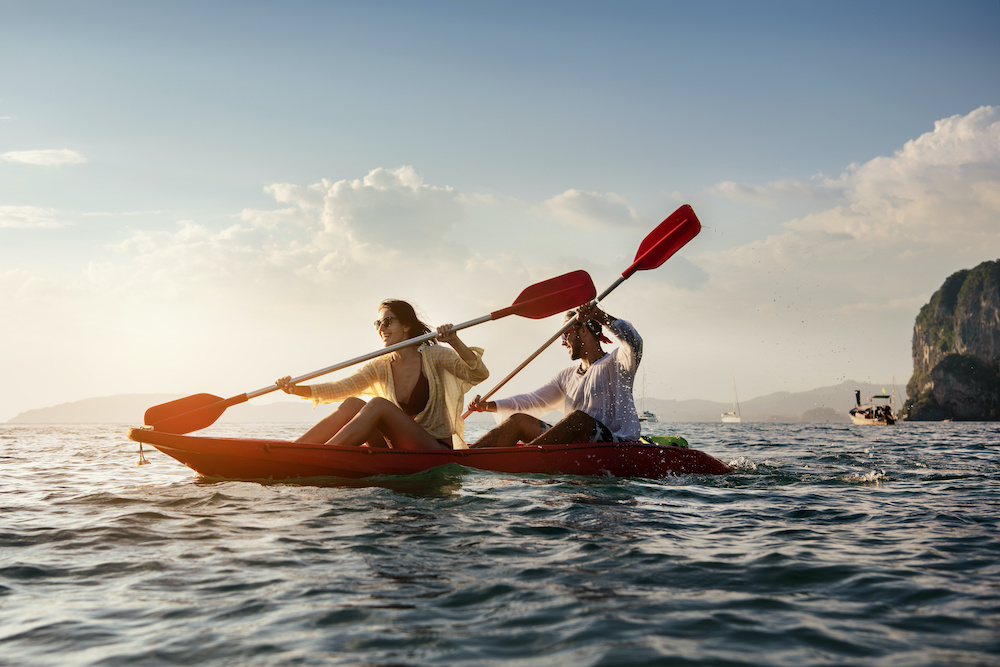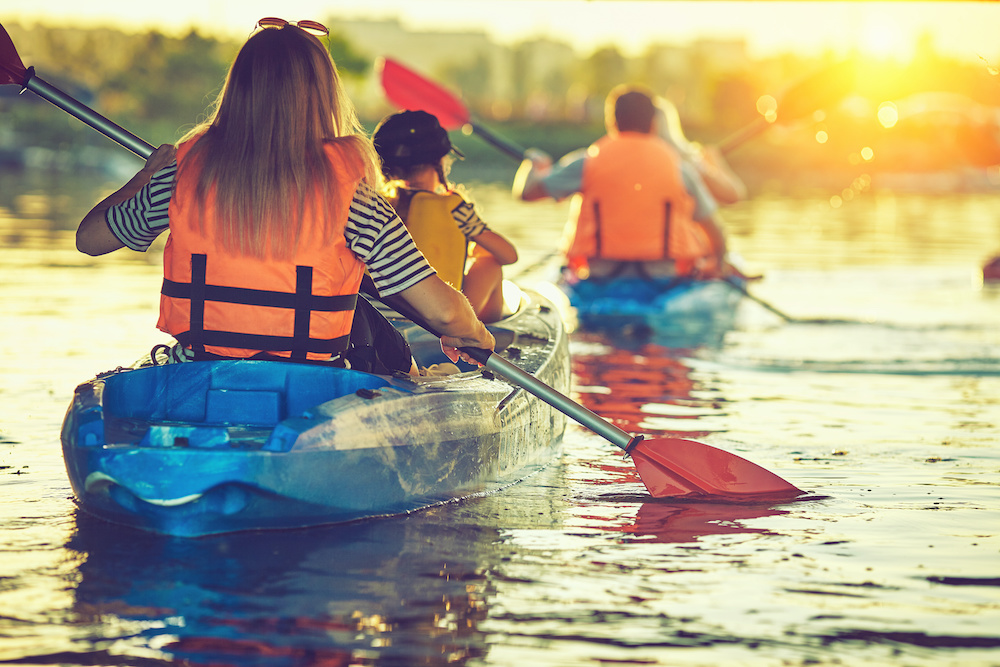What to Wear Kayaking?
We may earn a commission for purchases using our links. As an Amazon Associate, we earn from qualifying purchases.
Curious about what to wear kayaking?
What you wear kayaking is actually similar to what you should wear for other outdoor activities, like hiking or mountain climbing.
This is true, save for one exception—it has to interact well with water. After all, kayaking is still a water activity.
What to Keep in Mind When Choosing a Kayaking Outfit
Before we talk about the appropriate outfits to wear kayaking, here’s a few pointers to keep in mind first:
1. Your safety is most important.
Similar to any activity, you should put your safety at the top of your priority list.
Regardless of what you’re wearing underneath, you must always put on a personal floatation device on top and secure it properly.
2. Know which temperature to follow.
One common mistake when thinking about what to wear when kayaking is dressing up according to the current temperature.
You definitely have to account for the degrees out there, but not of the air.
Determine and prepare for the current water temperature instead.
3. Avoid wearing cotton.
Cotton may be comfortable and convenient to wear any other time, but it’s simply not meant for water.
It absorbs moisture quickly and doesn’t dry fast enough.
So, instead, you should be on the lookout for clothes made of quick-drying fabric.
Some fibers absorb moisture as quickly as cotton does but also insulate while doing so, like wool.
These materials are worth considering, too.
4. Abrasion-resistance is also a useful feature.
Clothes that don’t easily tear are a good choice, too.
Basically, it should protect you from the harsh elements you’ll be exposed to while kayaking, like sand and pebbles.
5. Make sure your clothing hardware is rust-proof.
Saltwater is particularly corrosive to metals.
While premium water gear usually has corrosion-resistant hardware, we recommend getting pieces with plastic components just to make sure.
6. Don’t forget the sun.
We suggest going for UPF-rated fabrics or clothing pieces that minimize your skin’s exposure to the sun’s harmful rays.
What to Wear Kayaking
Another factor to consider when figuring out what do you wear kayaking is the weather.
For your easy reference, we will divide this section into two further subtopics according to the usual temperature experienced during the seasons: hot and cold.
We will also divide each subtopic according to the different clothing categories: underwear, tops, bottoms, outer layers, and accessories.
Hot Weather Kayaking Gear
Here are clothing pieces to wear kayaking when it’s hot out:
Underwear
If you prefer it, you can opt to wear a swimsuit as your first layer.
You will also find underwear (like sports bras) designed for outdoor water activities.
Tops
Choose a form-fitting top made of quick-drying fabric, preferably with a high UPF rating for extra sun protection.
For this, rash guards are a great choice.
Bottoms
Boardshorts and quick-dry pants are our personal favorites.
We don’t recommend leggings that might chafe or tear easily, like yoga pants.
Outer Layers
You may already enjoy an afternoon of kayaking with the clothing pieces you have on so far.
However, depending on the weather, you might find it more comfortable putting a breathable jacket on top to minimize rain or wind exposure.
We recommend looking into paddling jackets since they are specifically designed to keep water out even while paddling.
Accessories
Finally, you can also put on a cap or a visor to protect your face from the sun.
A pair of gloves to prevent blisters would be a useful addition, too.

Cold Weather Kayaking Gear
If it’s usually cold where you’re from, here are clothing pieces to wear if you are planning to go kayaking:
Underwear
Putting on a wetsuit or drysuit with an insulation factor is highly recommended.
It can prevent your lungs and heart from the sudden drop in temperature, which may lead to hypothermia and drowning.
You can also put on long underwear beneath a dry suit.
Tops and Bottoms
Fleece layers can provide additional warmth as you’re kayaking.
Make sure you choose clothing items that don’t hinder your mobility.
Outer Layers
As an outer layer, we recommend looking for a waterproof jacket that provides additional insulation.
Accessories
Beanies and bonnets provide more warmth than a cap, so don one if you need to. Gloves, on the other hand, are a must.
Again, regardless of the season and how many layers of clothing you wear, you must always wear a personal flotation device.
Should You Wear a Bathing Suit Kayaking?
Speaking of being quick-drying and corrosion-resistant, you might be wondering if wearing a bathing suit is a good idea.
Honestly, that’s a smart way to go. Just make sure your chosen piece won’t hinder your mobility.
You can also opt to wear quick-drying layers on top of it.
Wetsuit vs. Drysuit for Kayaking
Wetsuits and drysuits are special pieces of clothing designed for use in many water sports.
Are these suitable choices for cold weather kayaking gear? How do they differ?
Looking at how they look is proof enough that wetsuits and drysuits don’t share the same functionality.
Wetsuits have a form-hugging fit, while drysuits look more like a hazmat suit.
Also, wetsuits are made of a neoprene material that can provide warmth even when wet. However, as the name suggests, it won’t keep you dry.
If you wish to stay dry when kayaking, you need to wear a drysuit, which is designed to completely keep the water out.
The problem with drysuits is that they are not usually designed to provide heat.
So, which one should you wear?
If you want to prepare for swimming despite the cold water temperature, wearing a wetsuit will be ideal since it provides more mobility.
If you believe that keeping your skin dry will give you a better chance for survival (such as during extremely cold weather conditions), wear a drysuit.
You can always layer beneath or on top of your drysuit for added warmth if needed.
Shopping for Wetsuits and Drysuits
Here are some tips when getting a wetsuit:
- Stitched seams are more prone to leaking, so choose taped or welded seams instead.
- Wetsuits vary in thicknesses. Getting an unnecessarily thick piece is not recommended since it can hinder your wetsuit’s flexibility. Research the average temperatures of your favorite locations to make a smarter purchase decision.
- Buying a wetsuit online is not recommended. Different brands don’t share the same cut and sizing. What is medium for a brand may be considered large for another.
- Wetsuits are sized according to specific body types. For example, some brands have multiple medium variants, including medium-short and medium-tall, to match different users.
Here are some tips when getting a drysuit:
- There are two types of drysuits: full and semi. They mainly differ in the material used for the next gasket.
- A full drysuit is made with a latex neck gasket, while a semi is made with neoprene.
- Latex can more efficiently keep you dry even during rough movements, but they are not that comfortable to wear, especially for extended hours.
- Neoprene won’t be able to provide a seal as good as latex. However, it is more comfortable to use.
- Drysuits also come in different zipper setups. There is no particular setup better than the other. It will simply boil down to your personal preference.
- Drysuits can be quite an investment. There’s nothing wrong with purchasing a used drysuit as long as it has not been abused. Some brands and shops also offer drysuit repair services.
What Shoes Do You Wear Kayaking?
One of the elements usually overlooked when deciding what to wear when kayaking is footwear.
Beginners seem to think that water sandals or flip-flops are enough since they will be inside the kayak anyway.
That’s not necessarily true. Your feet will also be exposed to the same elements as your entire body.
The ideal option is a pair of neoprene paddling booties.
They are lightweight, water-ready, and provide a lot of cover protection and support to your feet.
Water sandals don’t offer the same covered protection and may expose your feet to gravel, mud, and sand.
Finally, flip-flops and other types of footwear without a backstrap is the worst idea since they can easily come off when you encounter a little bit of action.
Your paddling booties will also work even during cold weather conditions. Just supplement it with thick non-cotton socks for added insulation.
You may also consider getting a pair in a slightly bigger size for cold weather kayaking.
What Should I Wear When I Go Kayaking?
Determining what do you wear kayaking should not be difficult.
As long as you know what factors to consider, you’d be able to make a smarter purchase decision.
The materials your chosen apparel is made of play a crucial role in its quality and comfort.
They also determine whether they are waterproof, provide insulation, or improve mobility.
Wetsuits and drysuits are popular options. They don’t share the same features and functionality, so it’s always ideal to do further research before buying anything.
Finally, wearing a personal flotation device is a must, even for really competent swimmers.
More than anything, it is the most crucial gear to put on when learning about what to wear kayaking.



